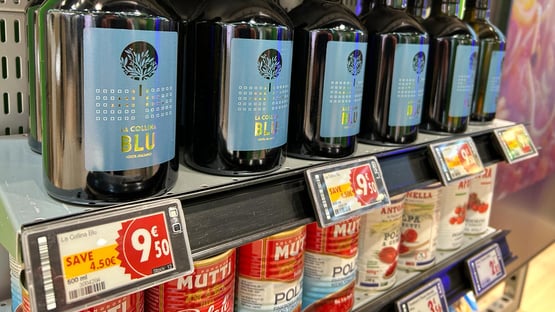New market drivers for ESLs in Bulgaria

Increasing labor costs, the need for quick price changes, and the introduction of the euro – these are some of the drivers behind the increased interest in solutions based on electronic shelf labels in Bulgaria.
Electronic shelf labels (ESLs) are a powerful tool for retailers in terms of price management and promotions. Solutions based on ESLs are very widespread throughout the world, as drivers for their rapid spread are the increased cost of labor, as well as the need for rapid price updates in stores related to promotional campaigns that are a daily routine for modern retailers, and inflation. In Bulgaria, electronic shelf labels will also be an important tool when the euro is introduced, said Maria Ivanova, Executive Director, SIS Technology AD, in the Business Start show of Bloomberg TV Bulgaria hosted by Hristo Nikolov.
Watch the Bloomberg TV news here
Electronic shelf labels are digital displays that are mainly used in brick-and-mortar stores to visualize prices and additional product information. Depending on the display, there are different technologies - LCD, graphic displays and e-paper ("electronic paper"), they also differ in size and which colors they can visualize.
“Each ESL manufacturer uses a different in-store communication technology. This communication has to be carried out in real-time and therefore changes of price or product information take place almost instantaneously when these changes are made and confirmed in the retail system”, said Maria Ivanova.
The labels can show various colors. With e-paper labels, there is almost no design limitation. You can visualize a picture, text, different prices, as well as a QR code, Ivanova added. “The main advantage is saving time when changing price. If a store with paper labels had to change the price of 500 products, it would take three employees and five hours, while with electronic shelf labels this is done in 35 seconds. The ESL system is integrated with the retailer’s system in the store, or the full chain, and works in real-time.”
In order to make an offer for equipping a store with a solution based on electronic shelf labels, in addition to the commercial area, one also takes into account how many labels there are and what type of label will be selected.
The retailer should investigate what the solutions are in the market because each ESL manufacturer offers a different technology of electronic label communication with the infrastructure of the site. Each technology has its advantages and disadvantages, and it is important that the customer is aware of them, said Ivanova.
“A mistake a retailer could make when choosing an ESL solution is to be guided solely by the unit price of an electronic tag, without considering its battery life, where and how it is replaced, and how much it costs in total. Last but not least, the retailer should analyze how the system software integrates with his retail system, which manages the store, because in some solutions this can be an expensive and long process, while in others it is relatively easy, fast, and does not make the deal more expensive.”
The Swedish company Pricer is a leading ESL solution provider on the global market.
“In Bulgaria, it is a fact that in the last two or three years more and more companies are entering this market. Our company started integrating electronic shelf labels in Bulgarian stores in Sofia, Burgas and Sunny Beach as early as 2007-2008. Back then, the labels had an LCD display, but then the economic crisis froze the projects.”
“In the last two or three years, there has been a lot of activity again and so far over 500,000 electronic labels have been installed in over 40 stores throughout the country. And we are currently in the process of integrating another 200,000 electronic shelf labels across the country.”
Currently, the technology used is radically different and much more developed than in 2007, Maria Ivanova stressed. “Things are not comparable to the cost of labor, to the timeliness and speed with which every retailer needs to do price changes and opportunities for promotions. Electronic shelf labels also support the introduction of the euro. So, the environment is different and now is the right time for retailers to invest in an ESL solution.”
When adopting the euro, retailers should do two things: “They need to adapt their in-store system to function with both currencies during the transition period, BGN and EUR, and change the design of the labels to visualize prices. This design change is done centrally, in one place and the actions that need to be taken with electronic shelf labels are minimal.”
Published on March 07, 2023